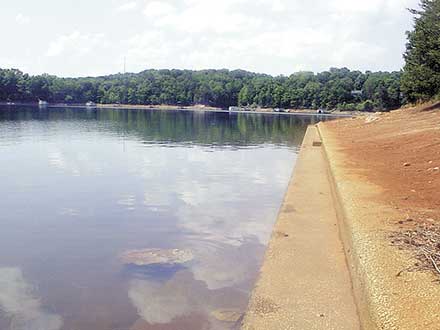
For many, Lake Sidney Lanier has always been here. You can’t imagine what the North Georgia landscape might have looked like without it. The older folks can, and when they start to tell their stories, they look at you with this mischievous sparkle in their eye, as if they know something you aren’t supposed to.
Their stories all start the same . . . ‘”Ya know, once upon a time, way back . . .”
What the old folks have to tell you leaves you wide-eyed in amazement.
I had no idea. Lake Lanier is full of secrets.
Ever since the Army Corps of Engineers completed construction of Buford Dam in 1952, and the backwaters of the Ole Hooch started filling in the cracks and crevices of North Georgia’s foothills, tall tales and legend have circulated throughout these parts about the secrets of Lake Lanier.
There was a good deal of disagreement over almost every aspect of the dam. Its uses (should it be designated to provide power, water or recreation), its location (originally proposed to inundate Roswell), even its name (Lanier would be chosen after the start of construction).
Many starting dates are given, from 1950 (dam construction begins) to 1959 (first time Lanier reaches its “full” level of 1071 feet above sea level), 1946 (the date the Army Corps of Engineers was charged with developing the project on the Chattahoochee River, but the birth of Lake Sidney Lanier actually began with the first purchase of land in 1948.
Shadburn’s Ferry marked the first physical move towards creating what would be known as Lake Lanier when 81-year-old Henry Shadburn of Forsyth County sold his 100-acre farm to the United States government for $4,100.
Shadburn’s Ferry would be only one piece of history destroyed by the creation of Lake Lanier. Also covered was the toll-gate run by James Vann, the entrance to the Georgia Road — later known as the Old Federal Highway, and a number of other ferries that crossed the Chattahoochee River. Many covered bridges were also lost, the most famous of which would be the original Brown’s and Keith’s Bridge.
Wooden structures that would be covered by Lake Lanier’s pool were removed. Concrete and brick structures were left in many cases. Graves were relocated, frequently from small, family graveyards that were common in these northeast Georgia hills.
Did you know that the depth of Lake Lanier at Buford Dam is 211 feet? That’s deeper than the Statue of Liberty is tall.
Lake Lanier covers an area of more than 39,000 acres of water and is comprised of 692 miles of shoreline.
Lake Lanier plays host to more than eight million annual visitors with 68 parks and recreation areas, twelve campgrounds with more than 1,200 campsites, ten full-service marinas with restaurants, gas docks, pump-out stations and boat storage.
Construction on Buford Dam began in 1951 and was completed in 1956 at a total cost of $45 million. Today, estimates of the economic impact of Lake Lanier exceed $5.5 billion annually, based on a study conducted by the Marine Trade Association of Metropolitan Atlanta in 2000.
More than $96 million in electricity has been produced by the powerhouse generators located at Buford Dam since 1957.
During the five years, it took Lake Lanier to reach its full pool depths of 1,072 feet above sea level, entire towns were consumed by the lake, like Oscarville on the Forsyth County side, bridges, old county roads, racetracks such as Looper Speedway off Laurel Park, and other lakes as well, such as Lake Warner off the end of Riverside Drive and old Chattahoochee Park, just down the hill from American Legion Post 7 headquarters.
More than 50,000 acres of prime farm and bottomland was bought from individuals and private companies. To make way for the lake, the Army Corps of Engineers moved more than 250 families, six churches, 15 businesses, and 20 cemeteries. Land was cheap back then, selling for about $50 an acre.
In April 1958, Lake Lanier claimed its most famous victim, Susie Roberts, long since known as Lake Lanier’s Lady of the Lake. Roberts lost control of her car and crashed off the right abutment of Lanier Bridge on Dawsonville Highway. Her car came to rest in ninety feet of water, on a steep slope at the base of the bridge, caught in the deadfall of sheered-off tree trunks that comprise the Lake Lanier bottom.
A year after the accident in 1959, divers discovered the body of Delia Mae Parker Young, believed to be a passenger in Susie Roberts’ car, but could never locate the car or remains of Miss Roberts.
With visibility being almost zero at that depth, Roberts remained undiscovered until November 1990 when construction on the new Lanier Bridge expansion was underway. Construction crews found Roberts car while dredging out the lake bottom to set the foundation pillars for the new bridge.
One of the casualties of Lake Lanier was Looper Speedway, a half-mile dirt track off Old Cleveland Highway at the point of what is now Laurel Park. Looper Speedway was owned by Max Looper. His nephew Edwin Looper worked there during high school, watering down the dirt track every Friday night before the Saturday races.
“We watered down the track before each race,” Looper said in a 2001 interview. “You couldn’t race on Sundays in Gainesville back then, so they ran races on Saturdays. They ran mostly ’39 Ford coupes, though one guy ran an old Plymouth.”
Looper Speedway closed in the 1950’s as the backwaters of Lake Lanier began creeping northward. “Gober Sosebee from Dahlonega raced out here,” Looper said. “As did Eddie Samples from Atlanta, Chester Barron out of Cornelia, and a woman, Sarah Christain from Dahlonega.”
A rarity back in those days Christian actually brought home the checkered flag one Saturday afternoon, driving Speedway owner Max Looper’s car.
“This is a died-in-the-wool fact,? Edwin Looper said.” Sarah Christian drove old Max’s car and won that race. Made all the men mad too, her being a woman and all, and winning the race.
When the lake levels plummeted to a near record 15 feet below full pool back in 2001, the top rows of the old concrete grandstand could be seen along the shoreline off Laurel Park. “There used to be ten to fifteen rows of concrete bleachers running along the track,” Looper said. Only four rows remain, the rest buried by lake bottom silt.
Today, instead of racing fans, schools of bass, crappie and sunfish gather around the old grandstand now, a popular Lanier fishing spot.
And speaking of fish . . .
“You know there’s catfish swimmin’ around the bottom of that lake that are the size of a ten-year-old boy.” The old fisherman scrapes a hand across his whisker-stubbled chin and offers a conspiratorial grin. They say, “half the lies this fella tells aren’t even true.” Still, you visualize what your ten-year-old looks like — about five feet tall and weighing somewhere between eighty and one hundred pounds.
That’s a lot of fish.
Taking into consideration the story teller’s creed of never letting the truth stand in the way of a good story, you wonder if there really are catfish the size of your fourth grader lurking in the murky deep of Lake Lanier. If anglers can full 42-inch Stripers from there, why not ninety-pound catfish?
Ever hear of the Chicken Truck story?
Every major lake, river, and reservoir across the Southern United States has a story like this one:
Divers performing maintenance work on a local dam encounter catfish the size of Volkswagens. They’re known as monster fish, and they live in the murky depths of lakes and river bottoms . . . and they’re known to swallow a small dog whole.
The Chicken Truck Story is a classic rural legend, and it takes place on Lake Lanier.
How big catfish can actually get is widely disputed. The record is supposedly a 123-pound flathead catfish caught in Kansas. Folks around these parts, however, swear cats have been known to weigh twice as much and often told stories about nearly landing one or being chased by one. Still, a flathead catfish weighing as much as a small adult is one big fish. Local fisherman Don Winkler looks at you with a twinkle in his eye when he talks about the Chicken Truck Story.
“Sure, it’s true,” he said and then segues into a story about how he caught the largest striper ever pulled from the waters of Lake Lanier. He lost the official record, he claims, because the record holder used a lighter test-line than he did.
“The chicken truck crashed off Thompson Bridge back in the 1980s,” Winkler said. “When divers investigated the wreck site, they came across catfish the size of twelve-year-old boys swallowing these chickens whole.” His daughter, according to Winkler’s Big Fish story, was one of those divers.
She never went diving in that Lake after this. Whether or not the Chicken Truck story is actually true doesn’t matter when considering whether monster-sized catfish really do exist along the bottom of Lake Lanier. Given the lake-bottom sediments and water depths, chances are good Lake Lanier plays home to some real leviathans of the deep.
Remember, it’s not so much the truth that matters when spinning a good yarn, but the story itself.

